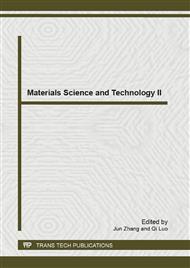[1]
G. Oberdorster, Z. Sharp, V. Atudorei, Translocation of inhaled ultrafine particles to the brain. Inhal Toxicol Vol.16. (2004), p.437.
Google Scholar
[2]
B. Wang, W. Feng, M. Zhu, Neurotoxicity of low-dose repeatedly intranasal instillation of nano- and submicron-sized ferric oxide particles in mice. J Nanopart Res Vol.11. (2009), p.41.
DOI: 10.1007/s11051-008-9452-6
Google Scholar
[3]
J. Wang, Y. Liu, F. Jiao, Time-dependent translocation and potential impairment on central nervous system by intranasally instilled TiO(2) nanoparticles. Toxicology Vol.254. (2008), p.82.
DOI: 10.1016/j.tox.2008.09.014
Google Scholar
[4]
C.Y.C. J. X. Wang, H. W. Yu, J. Sun, B. Li, Y. F. Li, Y. X. Gao, W. He, Y. Y. Huang, Z. F. Chai, Y. L. Zhao, X. Y. Deng, H. F. Sun Distribution of TiO2 particles in the olfactory bulb of mice after nasal inhalation using microbeam SRXRF mapping techniques. Journal of Radioanalytical and Nuclear Chemistry Vol.272. (2007), p.527.
DOI: 10.1007/s10967-007-0617-z
Google Scholar
[5]
G. Oberdorster, Z. Sharp, V. Atudorei, Extrapulmonary translocation of ultrafine carbon particles following whole-body inhalation exposure of rats. J Toxicol Environ Health A Vol.65. (2002), p.1531.
DOI: 10.1080/00984100290071658
Google Scholar
[6]
N.E.D. O. Rebai, Chronic Exposure to Aluminum Chloride in Mice:Chronic Exposure to Aluminum Chloride in Mice:. Advances in Biological Research Vol.2. (2008), p.26.
Google Scholar
[7]
A.A. Buraimoh, S.A. Ojo, J.O. Hambolu, Behavioural Enpoints of Adult Wistar Rats, Following Aluminium Chloride Exposure. British Journal of Pharmacology and Toxicology Vol.2. (2011), p.273.
Google Scholar
[8]
D. Ribes, M.T. Colomina, P. Vicens, Effects of oral aluminum exposure on behavior and neurogenesis in a transgenic mouse model of Alzheimer's disease. Exp Neurol Vol.214. (2008), p.293.
DOI: 10.1016/j.expneurol.2008.08.017
Google Scholar
[9]
H. Schulz, V. Harder, A. Ibald-Mulli, Cardiovascular effects of fine and ultrafine particles. J Aerosol Med Vol.18. (2005), p.1.
DOI: 10.1089/jam.2005.18.1
Google Scholar
[10]
A. Peters and C.A. Pope, 3rd, Cardiopulmonary mortality and air pollution. Lancet Vol.360. (2002), p.1184.
DOI: 10.1016/s0140-6736(02)11289-x
Google Scholar
[11]
G. Oberdorster, E. Oberdorster, and J. Oberdorster, Nanotoxicology: an emerging discipline evolving from studies of ultrafine particles. Environ Health Perspect Vol.113. (2005), p.823.
DOI: 10.1289/ehp.7339
Google Scholar
[12]
C.A. Pope, Air pollution and health - good news and bad. N Engl J Med Vol.351. (2004), p.1132.
Google Scholar
[13]
M. Roller, Carcinogenicity of inhaled nanoparticles. Inhal Toxicol Vol.21 Suppl 1. (2009), p.144.
Google Scholar
[14]
A. Mistry, S. Stolnik, and L. Illum, Nanoparticles for direct nose-to-brain delivery of drugs. Int J Pharm Vol.379. (2009), p.146.
DOI: 10.1016/j.ijpharm.2009.06.019
Google Scholar
[15]
A. Elder, R. Gelein, V. Silva, Translocation of inhaled ultrafine manganese oxide particles to the central nervous system. Environ Health Perspect Vol.114. (2006), p.1172.
DOI: 10.1289/ehp.9030
Google Scholar
[16]
G.W. Kreutzberg, Microglia: a sensor for pathological events in the CNS. Trends Neurosci Vol.19. (1996), p.312.
Google Scholar
[17]
U.K. Hanisch and H. Kettenmann, Microglia: active sensor and versatile effector cells in the normal and pathologic brain. Nat Neurosci Vol.10. (2007), p.1387.
DOI: 10.1038/nn1997
Google Scholar
[18]
F. Aloisi, Immune function of microglia. Glia Vol.36. (2001), p.165.
Google Scholar
[19]
T.C. Long, N. Saleh, R.D. Tilton, Titanium dioxide (P25) produces reactive oxygen species in immortalized brain microglia (BV2): implications for nanoparticle neurotoxicity. Environ Sci Technol Vol.40. (2006), p.4346.
DOI: 10.1021/es060589n
Google Scholar
[20]
X.B. Li, H. Zheng, Z.R. Zhang, Glia activation induced by peripheral administration of aluminum oxide nanoparticles in rat brains. Nanomedicine Vol.5. (2009), p.473.
DOI: 10.1016/j.nano.2009.01.013
Google Scholar
[21]
S. Tin Tin Win, S. Yamamoto, S. Ahmed, Brain cytokine and chemokine mRNA expression in mice induced by intranasal instillation with ultrafine carbon black. Toxicol Lett Vol.163. (2006), p.153.
DOI: 10.1016/j.toxlet.2005.10.006
Google Scholar
[22]
S. Tin Tin Win, D. Mitsushima, S. Yamamoto, Changes in neurotransmitter levels and proinflammatory cytokine mRNA expressions in the mice olfactory bulb following nanoparticle exposure. Toxicol Appl Pharmacol Vol.226. (2008), p.192.
DOI: 10.1016/j.taap.2007.09.009
Google Scholar
[23]
A. Campbell, A. Kumar, F.G. La Rosa, Aluminum increases levels of beta-amyloid and ubiquitin in neuroblastoma but not in glioma cells. Proc Soc Exp Biol Med Vol.223. (2000), p.397.
DOI: 10.1046/j.1525-1373.2000.22356.x
Google Scholar
[24]
D. Pratico, K. Uryu, S. Sung, Aluminum modulates brain amyloidosis through oxidative stress in APP transgenic mice. Faseb J Vol.16. (2002), p.1138.
DOI: 10.1096/fj.02-0012fje
Google Scholar
[25]
D.H. Smith, K. Okiyama, M.J. Thomas, Evaluation of memory dysfunction following experimental brain injury using the Morris water maze. J Neurotrauma Vol.8. (1991), p.259.
DOI: 10.1089/neu.1991.8.259
Google Scholar


